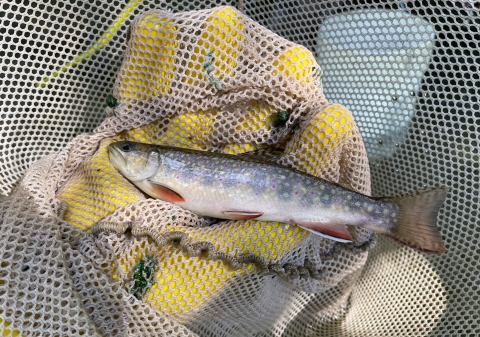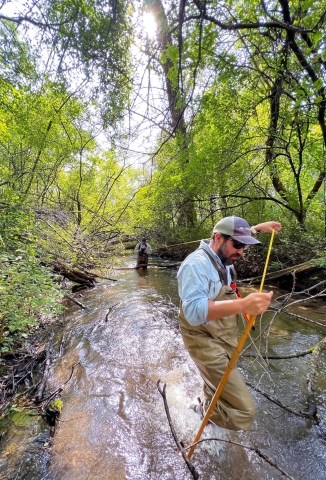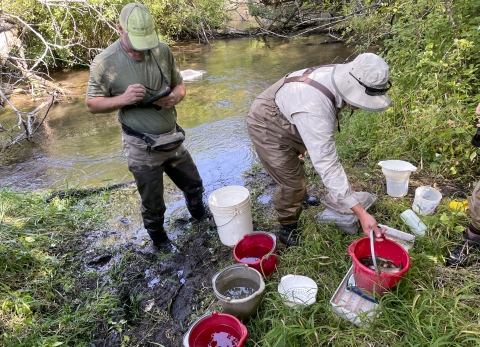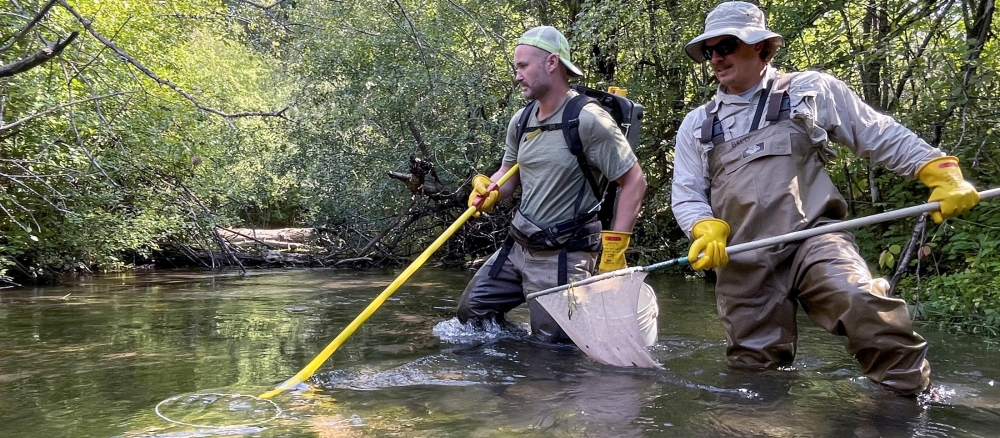One fish, two fish, a diversity of fish is good for the environment
The stream burbles as it tumbles over a half-submerged tree. The sound nestles into the narrow banks of the stream and barely floats out into the otherwise still woods. Lilting birdsong from the tree canopy overhead provides a peaceful reverie, occasionally interrupted by an electronic beep then a lunge and a splash in the water.
“Nothing but trout so far,” Brett Nagle calls out.
Nagle, a biologist with the Minnesota Pollution Control Agency, examines the fish he’s just caught in his net. The unremarkable brown trout measures maybe three or four inches long. It’s not the sort of prize a sportsman would hoist as a trophy but it nevertheless has untold value for determining the health of Minnesota’s waters.
Wearing waders to work

The trout goes into a five-gallon bucket with several others of similar size. Nagle and three other MPCA employees in the agency’s Environmental Analysis and Outcomes Division have already harvested about a dozen trout in the first minutes of a fish sampling excursion in Valley Creek, roughly a mile upstream from where the creek empties into the St. Croix River in Afton. The four all wear chest waders as they march through the sometimes-ankle-deep, sometimes-thigh-deep water. The chest waders might keep the water out, but the chill of the 55-degree Fahrenheit water on a crisp mid-September day still seeps in.
By Nagle’s side, Marshall Willems operates an electrofishing apparatus. The boxy, bulky backpack that he totes has several buttons and a screen on its hard plastic surface as well as two leads that dip into the water to form the electric current. In Willems’s right hand, he holds the apparatus’s anode, a long yellow wand with a bare metal loop at the end. As he runs the loop through the water, stunned fish float to the surface for Nagle to net.
“Definitely not legal to recreationally fish this way,” Nagle points out. It doesn’t harm the fish, though, and by the time Nagle places the fish into the bucket, they recover enough to flop around a bit.
Nagle and the team aren’t here to take blood or tissue samples or even to take the fish home. Rather, they’re just interested in how many fish and how many different species they can find in this 175-meter (about 575-foot) length of Valley Creek on one of their last sampling trips of the season. It’s one of 68 sites across the state that they’ve sampled on a roughly biennial basis since the program began in 2013.
It’s not just fish they’re observing, either. They need to examine the creek itself during this visit. Before the electrofishing starts, Will Varela steps into the water near a closed bridge on a gravel road and wades over to an embedded monitoring station that records the stream’s vital statistics: dissolved oxygen, pH levels, conductivity, and temperature. He also plunges a Secchi tube into the stream to measure water clarity; the further down he can see the black-and-white disk in the tube, the clearer the water. Varela calls out the figures while Nagle, standing on the bridge, enters them into a tablet.

Then, as Nagle and Willems head up the stream in search of fish, Varela and Dan Fettig trail behind to measure the stream’s width and depth at about a dozen points along the sampling area. Fettig says he also takes note of the condition of the banks and the substrate — the bottom of the stream, where the fish spawn —as well as the cover provided by vegetation or tree branches. He’ll also try to take measurements where the stream’s features change, whether that be at a beaver dam, at bends in the stream, or where it slows into deep pools. Valley Creek provides plenty of features: Not only does it twist and bend like an unruly garden hose, it’s also crossed by fallen trees and the gnarls of branches every dozen feet or so.
Those trees might force the four to awkwardly duck or high-step as they progress through the stream, but they also provide good habitat for the fish, which is why Willems makes sure to pass the anode ring under each half-submerged log and branch. Occasionally a fish will jump out of the water when it’s stunned, and one exceptionally obstinate fish backflips over the net.
Nagle foregoes chasing it to let it swim away downstream. “He earned that,” Willems says.
Once the five-gallon bucket gets heavy with fish, Nagle transfers it to the pen — a zippered net attached to a floating rectangle of PVC pipe. This keeps the fish from consuming all the oxygen in the water in the bucket and allows Nagle and Willems to keep collecting fish. Most of their catch is brown trout, a non-native species that has almost fully integrated into Minnesota’s waters, but they also see a handful of other species, including native brook trout.
In search of variety
While streams that are classified as warmer typically have dozens of species of fish swimming in them, colder groundwater-fed streams like Valley Creek tend to have less variety. That variety, along with the total fish count and the average length and weight of the fish, goes into an overall index of biotic integrity (IBI) score.
“We’re looking for community composition — what’s there and what’s not there versus what’s expected,” Nagle says. “We want to see diversity in the proportion of insectivores, omnivores, and piscivores. Some of those fish can adapt to adverse conditions better than others, so if we see an order of magnitude more of one fish than another, that points to the water quality. What we don’t want to see is an inflated abundance of something that thrives in disturbed habitats. That’s an indicator of something we don’t want to see.”
IBI scores range from zero to 100; the higher the score, the better the water quality. Any score above 63 in this particular stream’s classification indicates the water is healthy. Regular fish sampling — and the database of IBI scores that result — give a better picture of the variability of a stream in the face of pollutants, runoff, climate change, droughts, and heavy rain events, Nagle and Fettig say.

About two hours after they started, Nagle and Willems reach the end of the sampling section of Valley Creek and transfer the last of their catch to the pen. They then set up a scale, a measuring station, and a series of smaller buckets on a muddy bank of the creek where raccoons and other forest critters left tracks as they stopped for a nighttime sip of water. As the fish come out of the pen, they’re then sorted into one of the smaller buckets.
“Normally, we have 1,000 to 2,000 fish, so we set up with a big Rubbermaid tub and everybody takes a strainer and starts sorting,” Willems says. “It’s a very communal thing.”
But in this short stretch of cold-water creek, sorting, measuring, and weighing takes no time at all. By the time Fettig and Varela wrap up their measurements of the stream, they find that Nagle and Willems have finished the bulk of the work, so they take a look around. Varela finds a soccer ball that had drifted downstream from some long-ago curtailed game to get caught in a goalpost of low-hanging branches. He rinses it off in the stream and tucks it under his arm.
The final count is, as expected, heavy on brown trout: 148 of them, along with two brook trout, two lamprey ammocoetes, one yellow perch, and one white sucker. They range in length anywhere from three inches up to nearly a foot. Their weights and measurements go into Nagle’s tablet, and the fish themselves go back into the stream, maybe a little confused but otherwise unharmed.
Creek checkup complete
It’s not a lot of fish and it’s not a lot of variety compared to other sites they sample, but for Valley Creek, that’s about what Nagle and Fettig expected.
“Like many cold-water streams, it’s a simple community dominated by brown trout, so that count is typical,” Nagle says. “Even though there were just two of them, those brook trout will boost the score quite a bit, actually, and even the lampreys give the creek points for overall diversity.”
While the specific IBI score for this visit will require some calculation and the inclusion of the data that Fettig and Varela collected, Nagle and Fettig estimate Valley Creek will score somewhere in the 80s, on par with or even a little better than previous scores from the creek. That score and the creek's history make it a good reference site for other similar streams in the state.
With their buckets cleaned and stacked, the four pack up their equipment and make their way out of the woods via narrow deer trails. Once back on the road, Varela drops the soccer ball to the gravel and passes it back and forth with Nagle as they make their way toward their trucks to peel off their waders. The data they compiled will, once they get back into range, start uploading from the tablet back to the MPCA servers.
During the long winter, the desk work takes over. They’ll compile and analyze the data they captured today, compare it to historical data on this and many other streams across the state, and report their findings to other departments both in the MPCA and across state government. All the while, they'll wait for next summer when they can break out the waders and jump into more creeks to do it all again.
